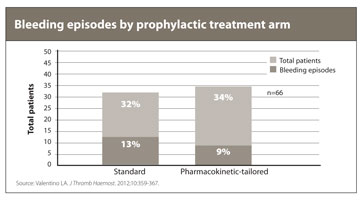Prophylaxis with Factor VIII improved bleeding events in hemophilia A
The use of either standard or pharmacokinetic-tailored Factor VIII prophylaxis significantly reduced bleeding events among patients with hemophilia A, according to the results of an international study.
In the study, 66 previously on-demand-treated patients with hemophilia A received 6 months of on-demand treatment with Factor VIII. They then were randomly assigned to treatment with standard prophylaxis or pharmacokinetic-tailored prophylaxis for 12 months.
All patients were aged 7 to 65 years and had baseline a Factor VIII level of 2% or less of normal.
Researchers sought to compare on-demand and prophylaxis treatment, as well as the two types of prophylaxis treatment. The primary endpoint was annualized bleeding rates.
During the on-demand phase of the study, 1,640 bleeding episodes were recorded, with at least one episode occurring in every patient. During the prophylaxis phase, only 33% of patients experienced a bleeding episode (see chart).

Source:
Standard prophylaxis and pharmacokinetic-tailored prophylaxis had similar annualized bleeding rates (1.6 for standard vs. 1.9 for pharmacokinetic-tailored).
Patients who completed the health-related quality-of-life questionnaire had statistically significant improvements for bodily pain and physical component scores.
“The demonstrated comparability of standard and pharmacokinetic-tailored prophylaxis regimens in terms of safety and bleeding prevention in hemophilia A patients indicates that pharmacokinetic-tailored prophylaxis is an effective alternative to the standard regimen with similar mounts of Factor VIII and one less infusion per week,” the researchers concluded. “Compared with on-demand treatment, both prophylaxis regimens significantly reduced bleeding, including spontaneous and traumatic hemarthroses, and improved the quality of life for adolescent and adult patients.
References:
- Valentino LA. J Thromb Haemost. 2012;10:359-367.
